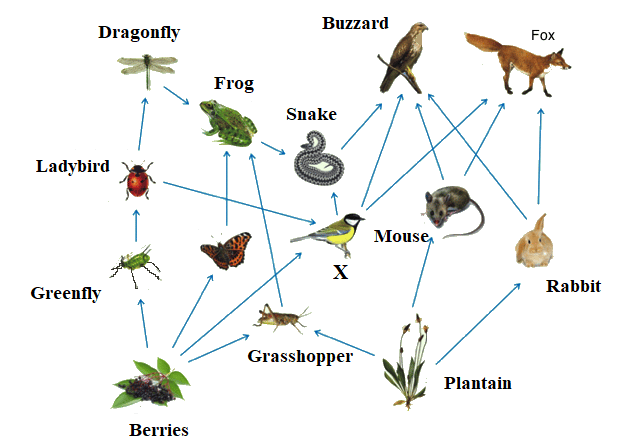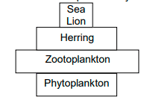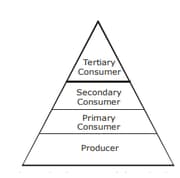
Identify the organism labelled as X in the above food web. (Specify common name)
Important Questions on Develop a model to describe the cycling of matter and flow of energy among living and nonliving parts of an ecosystem.
An illustration of a pyramid of a number of an aquatic ecosystem is given.

The pyramid of energy for the same ecosystem would be:
Name the plant that is used to make the soil Nitrogen rich.
a) Given below are some organisms. Arrange all of them in a food chain and show the direction of the flow of energy.
Eagle, grasshopper, frog, grass, snake.
b) Which of the organism in the above food chain has maximum amount of energy ?
c) Give an example of artificial ecosystem.
The following figure represents the flow of energy in a pyramid of food. If this ecosystem receives 100000 kcal of sunlight energy of the energy finally available to Tertiary Consumer (TC) is:

There is an increase in the atmospheric temperature year by year. If it continues, guess and write what could be the consequences?
Attempt the following:
(i) Construct a Food Chain with the help of the organisms given below:
Hawk, Grass, Snake, Hen.
(ii) Why is it not advisable to have a six-step food chain?
(iii) If Pesticides enter the above food chain.
(a) In which organism will it be found in the maximum amount?
(b) What is this phenomenon called?
Which of the following constitute a food chain?
Give reason:
Food chains generally consist of only three or four steps.
A food chain in a polluted aquatic ecosystem is given. Observe it and answer the following questions.
Freshwater Algae Fishes Birds.
(i) Which organisms are disturbed more due to biomagnification? Why?
(ii) This ecosystem will be destroyed gradually due to biomagnification. Why?
Algae, Hydrilla, grasshopper, rat, squirrel, crow, maize plant, deer, rabbit, lizard, wolf, snake, peacock, phytoplankton, crustaceans, whale, tiger, lion, sparrow, duck, crane, cockroach, spider, toad, fish, leopard, elephant, goat, Nymphaea, Spirogyra.

